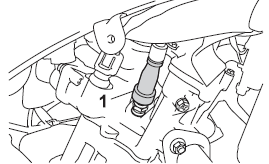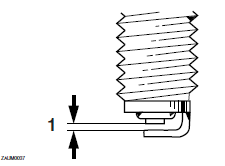Yamaha YZF-R125 Owners Manual: Checking the spark plug
The spark plug is an important engine component, which is easy to check. Since heat and deposits will cause any spark plug to slowly erode, the spark plug should be removed and checked in accordance with the periodic maintenance and lubrication chart. In addition, the condition of the spark plug can reveal the condition of the engine.
To remove the spark plug
- Remove cowling A.
- Remove the spark plug cap.

-
Spark plug cap
- 3. Remove the spark plug as shown, with the spark plug wrench included in the owner's tool kit.

-
Spark plug wrench
To check the spark plug
- Check that the porcelain insulator around the center electrode of the spark plug is a medium-to-light tan (the ideal color when the vehicle is ridden normally).
TIP
If the spark plug shows a distinctly different
color, the engine could be operating
improperly. Do not attempt to
diagnose such problems yourself. Instead,
have a Yamaha dealer check
the vehicle.
- Check the spark plug for electrode erosion and excessive carbon or other deposits, and replace it if necessary.
| Specified spark plug: NGK/CR8E |
To install the spark plug
- Measure the spark plug gap with a wire thickness gauge and, if necessary, adjust the gap to specification.

-
Spark plug gap
| Spark plug gap: 0.7-0.8 mm (0.028-0.031 in) |
- Clean the surface of the spark plug gasket and its mating surface, and then wipe off any grime from the spark plug threads.
- Install the spark plug with the spark plug wrench, and then tighten it to the specified torque.
| Tightening torque: Spark plug: 12.5 Nm (1.25 m.kgf, 9.0 ft.lbf) |
TIP
If a torque wrench is not available when
installing a spark plug, a good estimate
of the correct torque is 1/4-1/2 turn
past finger tight. However, the spark
plug should be tightened to the specified
torque as soon as possible.
- Install the spark plug cap.
- Install the cowling.
 Removing and installing the cowlings and panel
Removing and installing the cowlings and panel
Removing and installing the cowlings and panel
Cowling A
Cowling B
Cowling C
Cowling D
Panel A
The cowlings and panel shown need to
be removed to perform some of the
maintenance ...
 Engine oil and oil filter element
Engine oil and oil filter element
The engine oil level should be checked
before each ride. In addition, the oil
must be changed and the oil filter element
replaced at the intervals specified
in the periodic maintenance and lub ...
Other materials:
Checking the front fork
1. Stand the vehicle on a level surface.
WARNINGSecurely support the vehicle so that there
is
no danger of it falling over.
2. Check:
Inner tube
Damage/scratches Replace.
Oil seal
Oil leakage Replace.
3. Hold the vehicle upright and apply the front
brake.
4. Che ...
Operation and important riding points
Read the Owner's Manual carefully to
become familiar with all controls. If
there is a control or function you do not
understand, ask your Yamaha dealer.
WARNING
Failure to familiarize yourself with
the controls can lead to loss of control,
which could cause an accident
or injury.
TIP ...
Circuit diagram
4. Main fuse
5. Main switch
9. Battery
25.ECU (engine control unit)
36.License plate light
37.Tail/brake light
44.Headlight relay
46.Pass switch
47.Dimmer switch
51.Headlight (low beam)
52.Auxiliary light
54.Headlight (high beam)
58.Meter light
60.High beam indicator light
64.Ignit ...
